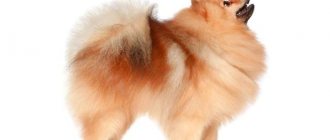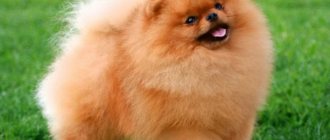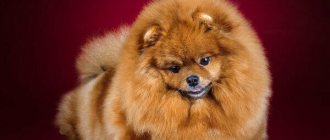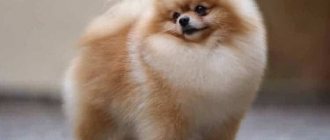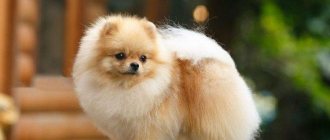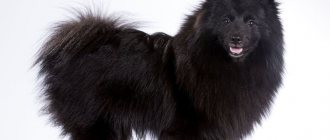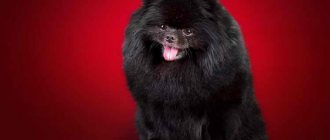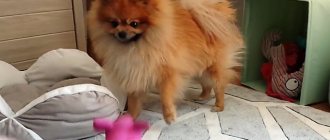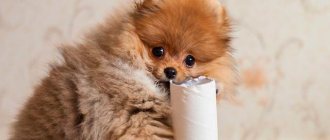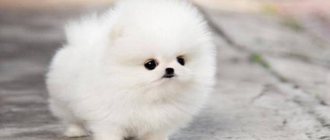You should properly and promptly care for your pet. When thinking about how to clean your Pomeranian's ears, it is important to remember these rules:
- It is necessary to remove hairs from the inside of the ears. Before trimming your Spitz's ears, it is recommended to initially wash the animal.
- In the process of removing fur hairs, you can either trim the Pomeranian's ears or pluck them from the ears. Plucking hairs is a fairly quick and painless method of removal.
- Once a week will be enough to inspect and clean your pet’s ears of dirt and possible discharge. When, upon examining the ears, no dirt was found, the skin of the ears is a natural pink color, and the dog itself does not shake its head or indicate any discomfort in the ears, then it will be enough to use a clean napkin or a cotton swab and gently wipe the ears.
- When cleaning, do not go deep into the ear, as this may cause injury to the eardrum or inner ear.
- If there is an unpleasant odor coming from the ear or there is uncharacteristic discharge, you should forget about self-medication and seek help from an experienced veterinarian. If, before cleaning the Spitz’s ears, changes in the color of the ear skin and excessive moisture in the auricle were detected, then this also symbolizes that it is necessary to take the pet to the clinic.
Spitz varieties
In addition to their cute faces, dogs have high intelligence. They are easy to train, smart and
curious. The content of a Spitz depends on the specific species, since its features in appearance and character are taken into account.
The German Spitz is very active and makes good guard dogs. Such a dog will not offend its owner and shows courage even in dangerous situations. Loves to walk and play sports, and take part in active games. Easy to train.
The white German Spitz was used in the development of the Japanese species. The peculiarity of the latter is its long snow-white fur, which can repel dirt. Therefore, caring for the coat is simple; it is enough to bathe it once every two months and comb it well during the molting period.
The Pomeranian Spitz is a sociable dog, loves to frolic with other animals, does not show aggression, therefore they are allowed to be kept together with cats. They are distinguished by their immense curiosity, so they hide wires and fragile things from them, and seal up cracks into which a furry animal can poke its head. Pomeranians come in fox and bear types. The latter are popular due to their cute round face, reminiscent of a plush toy.
The Dwarf Pomeranian Spitz feels comfortable in an apartment; you can take it with you, carry it in your arms or in a bag. In order for the animal to feel good and be active, it is important to know how to care for the Pomeranian and other varieties of the breed.
General characteristics of the breed
Pomeranians are suitable for private houses and apartments. They cannot be kept in an enclosure or on a chain near a kennel. Representatives of this breed have a complex character, so they are not recommended for novice dog breeders. With proper upbringing, the Miniature Spitz will become a good companion and protector for its owner.
The average life expectancy of an orange is 12-16 years. Thanks to its good mental abilities, the Miniature Spitz can quickly learn the preferences of its owner. The animal does not tolerate an indifferent attitude towards itself. It requires regular and careful care, long walks and active games.
Pros and cons of the breed
The advantages of the Pomeranian Spitz breeders include:
- good mental abilities and intelligence;
- courage;
- tendency to empathy;
- developed security and guard instincts;
- devotion;
- longer life expectancy;
- communication skills;
- possibility of apartment maintenance;
- decorativeness;
- compact sizes, etc.
Intelligence, loyalty, and courage are the advantages of the breed.
This breed also has many disadvantages. The main ones include:
- tendency to bark loudly;
- the complexity of socialization and education;
- increased excitability;
- severe shedding;
- fragile bones;
- need for careful care;
- tendency to wayward behavior, etc.
Feeding
Proper nutrition is the key to the health of your pet. The diet must be balanced and contain the required amount of vitamins and microelements. In addition, Spitz dogs are susceptible to allergies, so they choose food responsibly. Scarcity of food and lack of nutrients immediately affects the coat and behavior. The coat becomes dull and thin, and the dog's activity decreases.
There are three types of feeding:
- use of ready-made granules;
- natural food;
- combined nutrition.
The owner decides which one to choose. The main thing is that the dog does not have digestive problems. Switching from one type of feeding to another is acceptable. However, they do this gradually, over two weeks.
It is important not to overfeed your pet in order to avoid stress on the internal organs and not provoke the development of dysbacteriosis and diabetes. You should not give your dog food from a common table; there is a risk of allergies and disruption of the gastrointestinal tract.
The frequency of feeding an adult animal is twice a day, puppies are 5-6 times a day.
Natural nutrition
The main rule of natural feeding is the choice of quality products. It's better to buy fresh food at farmers' markets. The optimal methods of heat treatment are boiling, stewing, and steaming. Dishes must be at room temperature; hot and cold food is not allowed. The leftovers are immediately thrown away without saving for later. The bowl is rinsed after each feeding.
Dogs of this breed are a little capricious when it comes to food and may refuse some dishes. Therefore, caring for a Spitz can be difficult at times; it is worth working hard to create a healthy menu taking into account taste preferences.
List of permitted products:
- Lean meats, offal. Serve raw in large pieces.
- Boneless sea fish fillet, peeled mussels, shrimp, crabs.
- Water-based porridge made from buckwheat and oatmeal. Add pieces of meat, fish, cheese or vegetables. For variety, oatmeal or wheat is sometimes boiled.
- Raw, boiled, stewed vegetables. They prepare carrots, zucchini, beets, lettuce, and pumpkin.
- Raw fruits. Bananas, apples, melon, and persimmons are allowed.
- Sour milk. Low-fat kefir, yogurt, cottage cheese, and natural yogurt are suitable.
Meat dishes are a priority, making up half of the diet. Vegetables, fruits, cereals, and fermented milk are present in equal proportions.
Prohibited products:
- fat meat;
- canned food, semi-finished products;
- bones;
- sausage products;
- confectionery, chocolate;
- potato;
- oranges, lemons, strawberries;
- White cabbage;
- semolina, millet, pearl barley porridge.
In natural foods, the content of essential vitamins and minerals is limited, so the diet includes biologically active supplements selected by a specialist.
Industrial feed
From finished products, granules for Spitz or small breed dogs are recommended. They contain all the nutrients necessary in the diet, so additional vitamin complexes are not required. Dry food is convenient to use, it saves time on menu planning and preparation. It is important to purchase high-quality products, preferably canvas. The composition should not contain soy, dyes or stabilizers. Serving sizes are indicated on the package.
Eating dry food involves consuming large amounts of liquid. Water is placed next to food and updated daily.
Mixed feeding
Veterinarians allow the combination of food with industrial pellets, although this type of feeding is rare. The basic rule is not to give your dog both natural and ready-made food. It would be optimal to add a serving of dry granules during the day and regular food in the evening.
The frequency of feeding and the size of portions depends on the pet’s lifestyle, activity, physical condition, and age. Thus, old and sick dogs require less food, while young energetic Spitz dogs and pregnant and lactating bitches require more. In autumn and winter, the number of feedings is increased; in hot weather, light feeding is practiced in combination with a large volume of liquid.
Height (size) and weight of the dog
I have already talked a little about the size of the dwarf Spitz and the effect of growth on the ability to give birth, now I will make small clarifications. According to the standard, the height of a dwarf Spitz should be 18-22 cm at the withers. Spitzes with a height of 23cm or more fall into the next category - the category of small Spitzes. It happens that at an early age it is difficult to determine the future size of an adult dog. Therefore, if you are choosing a bitch with the goal of having offspring, this issue must be taken seriously. To avoid problems during childbirth (caesarean section, removal of tubes, death from anesthesia), you need to choose a large female at the upper limit of a dwarf, that is, her height should be about 22 cm.
Male dogs also have their own characteristics. “For your pillow” you are free to choose a male dog of absolutely any height. But if you want to breed with your male, choose a smaller puppy, because for dwarf breeds the following mating rule applies: the male must always be smaller than the female.
Based on this, it is easy to conclude that breeders often breed small Spitz bitches with dwarf males; the litter from this mating is divided into two parts: some of the puppies born are small Spitz, and some are dwarf. But, despite this, all puppies will have “dwarf spitz” written in the breed column. Therefore, be sure to ask the breeder about the height of the puppy’s parents. But even if only dwarf Spitz were involved in the mating process, this does not guarantee that there will be no small Spitz in the litter. This is genetics, and it is impossible to predict in which litter this could happen. No one is immune from the case when a dwarf Spitz grows into a small one. An honest professional breeder will try to warn you about this in advance, and will write in the puppy card: “size review at 6 months.”
Grooming
The main advantage of the breed is its luxurious fluffy coat, the condition of which must be maintained. Grooming is used in caring for the Pomeranian Spitz. Includes bathing, brushing and shaping of the coat according to the breed standard. If cleaning the coat and brushing can be done at home, then it is better to entrust the haircut to a dog groomer.
Bathing
Water procedures for Spitz are carried out once a month. The breed does not need frequent bathing, only if the animal gets dirty during a walk. Another reason for a Spitz to wash is participation in exhibitions and other events. Use shampoo and conditioner for long-haired dogs.
Bathing is carried out in several stages:
- The pet is placed in the bath and rinsed with a warm shower.
- The shampoo is squeezed into the palm of your hand, a little water is added, washed out and evenly applied to the dog’s body.
- Massage with both hands, then rinse well with water.
- It is recommended to do the procedure twice. Afterwards use conditioner to make combing easier.
It is important that when bathing, water does not pour into the ears. To do this, the ears are pressed or plugged with cotton wool.
Combing
Caring for a Spitz means constantly fighting the formation of mats. Long and thick coat requires regular brushing. The cover is pre-moistened, the procedure begins from the head, gradually moving to the body and tail. The Spitz fur is distributed into small bunches, each individually combed out.
To make your dog look good, you will need grooming tools:
- Pukhoderka. Soft with a rubber base, easy to use. Necessary for frequent use to prevent tangles from forming.
- Double sided comb. Made of metal. One row has sparse teeth, and the second has frequent teeth. Processing is carried out on each side in turn, starting with rare teeth. It is important not to press on the comb, otherwise you may injure the animal’s skin.
- Spray. Facilitates the care of your Spitz, making combing easy and comfortable, and adds shine to the coat.
- Cheska made from natural materials. Used to add volume and lightness. The treatment is carried out against the grain.
The Spitz has two strong molts - when the puppy grows up and after the bitch gives birth. During these periods, caring for the dog involves special care for the coat, and the frequency of brushing is increased.
Everything you need to keep the coat in perfect condition can be purchased at a pet store.
Haircuts
Caring for your Pomeranian includes maintaining a neat appearance. To ensure that the coat keeps its shape and the dog does not look overgrown, it is necessary to visit a hairdresser. The main thing in a haircut is accuracy.
First the ears are processed, then the collar and then move on to the body. The final stage is the design of the legs and tail. When creating a hairstyle, different types of scissors and a machine are used.
Common Pomeranian haircuts are bear, fox, lion cub. Sometimes they practice a mohawk or original tufts.
Chlorhexidine is a universal remedy
How to apply the product? This is a natural antiseptic, which, like hydrogen peroxide, is very often used in everyday life. They can cauterize wounds, treat severe cuts, and also disinfect the ears of pets. In addition, this procedure should be carried out after each cleaning for prevention.
But you should not clean your pet's ears with chlorhexidine. It can be used only in one case : when during the cleaning process you notice alarming signs of the development of the disease (redness, discharge and a strong, unpleasant odor), but there is no opportunity to visit a veterinarian and receive qualified help. Then you should drop a few drops into the dog’s ear and massage it gently. It is worth remembering that such a procedure will help relieve only a certain part of the symptoms, therefore, in order to completely eliminate the disease, you will have to undergo a full examination and course of treatment.
Hygiene
Caring for a Spitz at home requires strict adherence to hygiene standards. In addition to bathing and brushing, attention is paid to the ears, eyes and teeth.
Ears
The breed rarely suffers from hearing pathologies, so apart from timely cleaning, no additional measures are required. Pomeranian Spitz care includes ear treatment.
They do this regularly, as dirt from the street and sulfur secretions accumulate.
It is recommended to clean your dog's ears with cotton pads. Sticks are prohibited; insertion can injure the ear canal.
The discs are pre-moistened with herbal drops or glycerin lotion. Movements should be sweeping, light, without physical effort. The procedure is carried out at least once every five days.
If the skin on the ear is deformed or unusual discharge appears, you need to visit a veterinarian.
Teeth
To keep your mouth healthy, your Pomeranian's teeth need to be brushed at least once a week. To do this, use toothpaste and a dog brush.
It is also permissible to brush your teeth with a piece of gauze folded and wrapped around your finger. This method removes the resulting plaque. Suitable for puppies and adult dogs with increased sensitivity.
You can replace brushing your teeth with dendrological bones. They clean off tartar well, relieve discomfort when changing teeth, and at the same time serve as entertainment and a treat for the animal. There are products enriched with vitamins and microelements.
Dental care is very important as small breeds are susceptible to dental problems.
Eyes
Wash when dirty. Wipe with a cotton pad soaked in clean water. Treatment with medicinal herbs, such as chamomile or calendula, will be useful. Decoctions remove redness, suppress the development of inflammatory processes, and eliminate microbes. The procedure is done after the walk.
The eyes should be clean and transparent. The presence of purulent discharge indicates infectious lesions, in which case the Pomeranian should be shown to a doctor. Regular, profuse lacrimation is also a reason to contact a veterinarian.
Development by months
In the process of growing up, the following main stages are distinguished, by which one can determine whether the dog’s health and development are normal.
First month
At birth, Pomeranians appear tiny. Their weight ranges from 50 to 130 grams. In relation to the bitch, this is only 5 percent. Other German Spitz are slightly larger. Naturally, male Pomeranians are larger than female Pomeranians.
In the photo you will see how Spitz are born:
Newborn puppy
The skin is still visible through the faint fuzz. The puppies' heads are quite large compared to their bodies, which are very short with a plump belly. At first, the body parts are disproportionate, and the baby himself is helpless.
Reference . The color of the baby's skin indicates the future color of the Spitz's coat.
It is important to monitor the color of the puppies' skin, and if a blue tint appears, contact your veterinarian immediately. This color may be a sign of serious illness.
Two weeks after birth:
- babies begin to get up;
- eyes - see (puppies begin to recognize others);
- The ears begin to hear only by the 18th day.
After three weeks, the puppies begin to go to the toilet on their own; maternal assistance in emptying is no longer needed. Babies will begin to move actively only towards the end of the first month.
Second and third month
When babies are already two months old, baby teeth begin to emerge. Puppies begin to be capricious and constantly chew on something. It is at this stage of growing up that you buy special toys for your kids and put things away to keep them safe. At this age, the character changes, and the puppy prepares to part with its mother. He can already be walked, but only after having received vaccinations.
At three months the first molt begins, the puppy's fur changes to an adult fur coat. At this time, you can accurately determine what color the pet will grow up to be. The ears are actively growing, and the muzzle becomes elongated.
Dog at 2 months
Fourth and fifth month
In the fourth month of life, Spitz dogs become almost completely bald due to shedding, and therefore have a very unsightly appearance. This is because the thick undercoat sheds more slowly than the main coat, which is what makes these dogs so cute. First of all, the paws and muzzle go bald, and then the rest of the body.
If the puppy has gone completely bald, simultaneously losing its undercoat and fur, consult a veterinarian. He will review the diet and prescribe a vitamin complex.
At this age, teeth are actively changing. He quickly gains weight and height at the withers. The Spitz acquires standard proportions.
Sixth to ninth month
During this period, babies continue to actively grow and shed. By eight months, the teeth are completely replaced by molars.
Check your mouth regularly to avoid bite defects. Spitz dogs have powerful teeth with deep roots, which can affect their timely replacement.
If you see that the molar has grown, but the baby tooth has not yet fallen out, take your pet to a canine dentist. Untimely removal of primary molars leads to improper bite formation and tooth decay that did not fall out on time.
At 9 months, Spitz dogs reach show age. The coat is fully formed and a presentable appearance appears.
At 9 months
1 year
For females, this period means the first heat, but it is still too early to breed them. The boys begin to actively mark their territory.
By definition, at this time the last strong moult ends, the fur becomes adult. The next moults will not be as abundant.
At one year old, pets stop growing and begin to actively gain muscle mass.
In one year
2-3 years
Spitz dogs finally grow up by two years of age. Bitches begin their menstrual cycle and are ready to give birth. At two years the body is fully formed, in accordance with recognized breed standards.
Walk
Even though dogs can do toilet chores at home, walking is considered an important part of caring for your pet. The breed tolerates adverse weather conditions well. To prevent furry dogs from getting dirty and freezing, wear waterproof or insulated overalls.
Staying outside has a beneficial effect on the health and socialization of the Spitz. The animal's muscles are worked out, blood circulation improves, and metabolism is activated. A walk on dog parks gives the dog an opportunity to make new friends and burn off energy.
Don't forget about the leash. It can be difficult to keep track of a small, active lump. Spitz dogs often run out onto the road and are attacked by larger dogs.
Owner reviews
Spitz is our first and favorite dog. We were very worried about how to make sure that the baby developed correctly. But, as it turned out, if you stick to the regime and ensure compliance with the standard, he will grow up healthy and beautiful.
We are already two years old. The girl is fully formed. We are planning to take him to the next heat. All that remains is to find the right boy.
This is our second Spitz. The first boy was fed natural food, but there was not enough time for the second. As a result, boys are different sizes. The one who ate natural foods grew larger.
Source
Training
In order for the pet not to be naughty and to obey the owner, you should pay attention to him and be patient. You can come to an agreement with a Spitz, but the use of physical force will not lead to anything good.
Care and maintenance includes training, and each species requires an individual approach.
The Pomeranian learns through play accompanied by praise and treats. The dwarf representative loves to dominate, so the owner needs to be stricter and not indulge the pet’s whims. The German Spitz also tries to take a leadership position. Thanks to his high intelligence, he is productive and quickly remembers commands. Japanese does not mind long exercises and interesting tasks.
The results of training are reinforced during walks. Spitz are smart dogs; if desired, they can be trained in circus acts.
Recommendations for choosing a puppy
If you have firmly decided to get a Spitz, you will be faced with the question: how to choose a healthy puppy and what to look for when choosing? To make the right choice, you should answer the main question: why and for what purpose are you purchasing a dog? The answer to this question, firstly, will guide you on the cost of a Spitz, because the price of puppies varies and depends on the purpose of the dog, and secondly, it will help you understand what kind of life your pet and you will lead with it.
Selection of toys
Those who know about Spitz know how playful they are. This applies not only to puppies, but also to adult representatives. A sufficient number of toys in the apartment ensures the integrity of furniture and other interior items.
When selecting toys, you must use the following rules:
- The size must match the size of the dog. Those considered optimal for puppies are not suitable for adult dogs;
- things made of plastic are prohibited, as are tweeters with small parts;
- toys need to be updated periodically. The pet will gradually get bored with the old ones, and he will switch to surrounding objects;
- Pomeranians love plushies. You can give an old soft animal to be torn to pieces by first removing the plastic elements from it;
- It is good to use toys made from bull veins in the form of bones. They will not only entertain the animal, but will also clean the Pomeranian’s teeth from any stones that have formed.
Nuances in the development of different subspecies
The maturation of different types of Spitz proceeds approximately the same. Regardless of the breed, the development from a baby to an adult dog takes three years. They reach their final size by about six months.
There are some features:
- One litter may produce pets of different weight, height and color.
- A miniature size that does not meet standards may indicate the presence of diseases. Harnesses and collars are not suitable for these puppies. They should not jump from heights to avoid damaging their joints.
- If your pet is larger than the accepted standards, accept it. Most often, the reason is the presence of large individuals in the pedigree. It is impossible to influence the size of a pet without harming its health.
